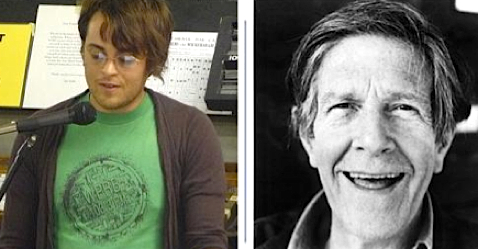
I’m extremely pleased that Al has graciously allowed me to initiate the symposium [as staged on December 6, 2010] with a discussion of John Cage’s Cartridge Music — a published work materialized by the electronic erasure of its own writing.This remarkable piece underscores some of the fundamental questions of the 1960 project: how are we to experience or historicize, much less write through a moment of cultural and literary history? What means of access do we have to 1960, represented by a selective cross-section of various activities and productions, intertexts and unlikely connections, uncanny harbingers and anticipatory plagiarists across 366 calendar days?
I’m particularly delighted to present in this live-form group-blog format — discussing selected artifacts in the context of a disjointed series of abbreviated “posts” from the forthcoming respondents here at the Kelly Writers House. I’ve been following Al’s one-man show, the marvelous 1960 blog, for a number of years. Reading historical artifacts as he does, relating each within the immediately contemporaneous context of a single year, brings to screen what Theo van Doesburg called a “space, simultaneously agitated in all directions.” [1] This work extends out into innumerable points of intertextual reference, while the references differentially locate the work in historical space-time.
One of Cage’s first forays into electronic composition, Cartridge Music served as a tool for composing the famous essay “Where are we going? And What are we doing?,” delivered a year after the score’s publication in 1960. From here, the piece underscores everything from glitch-hop and noise to No Input or Onkyo-tei sound art in Japan (if you spend any time at noise shows, you’ll find the score outlines the structure of most anarcho-improvisatory electronic music operant today). The premise seems simple: remove the needle from a phonographic pick-up — oh dear, I hope I haven’t lost anyone, my generation has lost touch with analog pick-ups — a cartridge forms a relay between the needle, which sits in the groove of a record, and an amplifier, which amplifies the vibrations into projected sound through a loudspeaker. So you replace the needle with “all kinds of small objects […] such as pipe cleaners, matches, feathers, wires, etc.” which you can then scratch along the grooves and surfaces of anything you like, from a cymbal to a body to the floor of the stage. [2] The vibrations in the replacement needle are then amplified into massive abstract sounds. There’s also an iconic score of insanely difficult visu-tempo-musical complexity and contact mic variants. We can highlight how Cartridge Music modulates Cage’s earlier statements on indeterminacy: previous to 1960, Cage “had been concerned with composition which was indeterminate of its performance; but, in this instance [Cartridge Music], performance is made indeterminate of itself.” [3]
He combats the static historical remnant of the work by formal definition, scripting all elements of transmission and inscription. Like a painting to be burned or a happening that forbids audiovisual recording, Cartridge Music replaces the needle, that perennial tool of decipherment and inscription, with absurdly ineffectual writing objects: slinkies, toothpicks, feathers, miniature American flags, and so on, all of which scream their objecthood in an electric wail over the performer-controlled loudspeaker in a moment of time-space. Our quandary is in attempting hear Cartridge Music today. While there are occasional recordings, it in fact shouldn’t (or doesn’t) exist. The recording needle intrudes on the piece — as Kittler reminds us, citing Rilke’s dream of tracing the coronal suture of the human skull, or the fantasy of reanimating Goethe’s larynx — replaying a recording Cartridge Music is a technical impossibility (if, for Kittler, the gramophone presents the real, Cartridge Music plays the unreal). [4] To deform Cage: “Cartridge Music uses several media performing programs that they have determined by means of the materials. But one media’s actions unintentionally alter another media’s actions, because the actions involve changing the amplitude controls and the inscription controls. So you may find yourself playing something and getting no sound whatsoever.” Cage continues in 1980: “I’ve worked with David Tudor in what we call live electronic music. Synthesizers lead toward a taped version of something that is fixed, and I’ve tried to keep things changing. I myself don’t keep a collection of records. The few records I have I don’t use as records because I don’t have a machine to play them on.” [5]
In his book How Early America Sounded, Richard Cullen Rath shares a marvelous Cagean anecdote that I’d like to rebroadcast in conclusion:
The Puritan John Gyles wrote a short book during the 1690s. In one part, he described happening upon what sounded to him like “a Woman washing her Linnen with a batting staff.” He was in the deep forest, though. As he investigated closer, he found that the sound came from land turtles “propogating.” He had, he claimed, heard them from half a mile away. Presumably, the turtles would sound the same today. Gyles was writing for an audience that he assumed knew the sound of batting staffs on laundry, a sound no longer common to life in the twenty-first century. The turtles let us listen in not only on their amorous adventures, but on a sound culled from everyday life, one that marked the hearer as being within a half a mile or so of a familiar community. [6]
[1] Theodore van Doesburg, "Film as Pure Form," trans. Standish Lawder, Form, no. 1 (1966): 7-8.
[2] “Cartridge Music,” John Cage Database, http://www.johncage.info/workscage/cartridge.html.
[3] Gil Weinberg, “Interconnected Musical Networks – Bringing Expresion and Thoughtfulness to Collaborative Group Playing,” (diss., Massachusetts Institute of Technology, 2003), 28.
[4] Friedrich Kittler, Gramophone, film, typewriter (Stanford: Stanford University Press, 1999, http://books.google.com/books?id=zSrte54_9ZwC&pg=PA43&lpg=PA43&dq=kittl…; http://books.google.com/books?id=zSrte54_9ZwC&pg=PA43&lpg=PA43&dq=kittl…;.
[5] John Cage, Conversing with Cage, ed. Richard Kostelanetz (London: Psychology Press, 2003), http://books.google.com/books?id=PjUIbHb7lFcC&pg=PA89&lpg=PA88&ots=Kjvr….
[6] Richard Cullen Rath, How Early America Sounded (Ithaca: Cornell University Press, 2005), http://books.google.com/books?id=0946oDkasdIC&printsec=frontcover&dq=ri….

